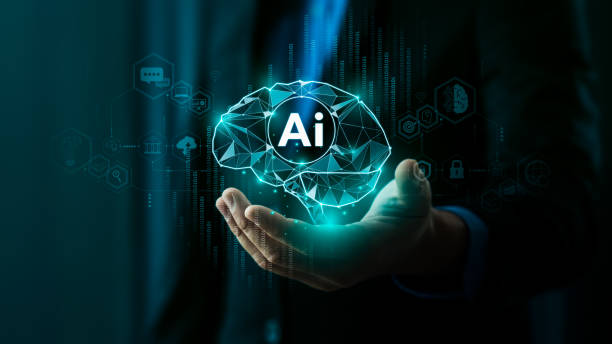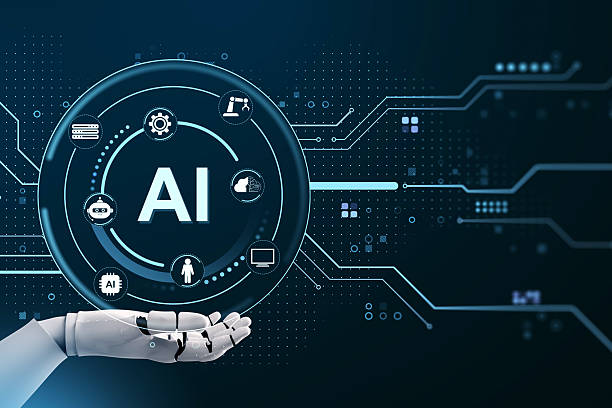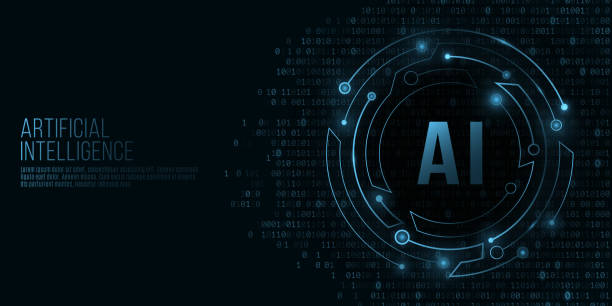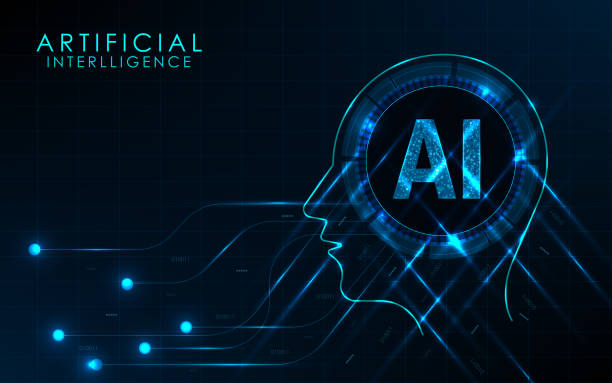What is Artificial Intelligence and What are its Applications?

#Artificial_Intelligence (AI) is a branch of computer science that deals with building machines and systems that can perform tasks that typically require human intelligence.
These tasks include learning, reasoning, problem-solving, natural language understanding, and pattern recognition.
In short, artificial intelligence strives to simulate human cognitive abilities in machines.
The applications of artificial intelligence are vast and diverse.
In the field of healthcare, artificial intelligence can help diagnose diseases, develop drugs, and provide personalized care.
In the automotive industry, artificial intelligence is used to build self-driving cars that can drive without human intervention.
In the financial field, artificial intelligence can help detect fraud, manage risk, and provide personalized financial services.
Also, in the field of education, artificial intelligence can help provide personalized training and evaluate student performance.
Artificial intelligence is rapidly advancing and is expected to play an even more important role in our lives in the future.
However, the development and use of artificial intelligence also requires attention to ethical and social issues to prevent the misuse of this technology.
Artificial Intelligence on Wikipedia provides more information in this area.
Do visitors to your online store leave before buying? Don’t worry anymore! With Rasaweb’s professional online store website design services, solve the problem of not converting visitors into customers forever!
✅ Significant increase in conversion rates and sales
✅ Unique and attractive user experience
⚡ Contact us now for a free consultation!
Types of Artificial Intelligence: Approaches and Classifications

Artificial intelligence can be divided into different categories based on abilities and different approaches.
In terms of ability, artificial intelligence is divided into two main categories: #Weak_Artificial_Intelligence (Narrow AI) and Strong Artificial Intelligence (General AI).
Weak artificial intelligence is designed to perform specific tasks and performs well in the same area.
Examples of weak artificial intelligence include voice assistants such as Siri and Alexa, movie and music recommendation systems, and facial recognition systems.
In contrast, strong artificial intelligence (AGI) refers to a system that can perform any task that a human performs with the same level of efficiency and intelligence.
Currently, strong artificial intelligence is still under development and has not been fully realized.
In terms of approach, artificial intelligence is divided into two main categories: #Machine_Learning (Machine Learning) and symbolic approaches (Symbolic AI).
Machine learning is an approach in which systems learn using data and identify patterns.
This approach includes algorithms such as supervised learning, unsupervised learning, and reinforcement learning.
Symbolic approaches are based on representing knowledge symbolically and using logical rules for reasoning and problem solving.
Understanding these categories helps us understand what artificial intelligence is capable of and how it can be used in different fields.
Machine Learning and its Role in the Development of Artificial Intelligence

#Machine_Learning (ML) is one of the most important sub-branches of artificial intelligence that allows systems to learn from data without explicit programming.
In fact, instead of the programmer directly telling the system how to perform a task, the system analyzes the data, identifies patterns and relationships, and learns how to make decisions automatically.
Machine learning is divided into two main categories: Supervised Learning, Unsupervised Learning, and Reinforcement Learning.
In supervised learning, the system is trained using labeled data.
This means that the data has defined inputs and outputs, and the system learns how to relate the inputs to the corresponding outputs.
In unsupervised learning, the system is trained using unlabeled data and must automatically discover patterns and structures in the data.
In reinforcement learning, the system interacts with an environment, receives rewards or penalties, and learns how to adjust its behavior to earn the most rewards.
Machine learning plays a very important role in the development of artificial intelligence.
Many artificial intelligence applications, such as image recognition, natural language processing, and recommendation systems, are built on machine learning algorithms.
| Learning Type | Description | Examples |
|---|---|---|
| Supervised Learning | Learning using labeled data | Image recognition, price prediction |
| Unsupervised Learning | Learning using unlabeled data | Customer clustering, dimensionality reduction |
| Reinforcement Learning | Learning by interacting with the environment and receiving rewards | Computer games, robotics |
Natural Language Processing and Understanding Human Language

#Natural_Language_Processing (NLP) is another important sub-branch of artificial intelligence that enables systems to understand, interpret, and generate human language.
NLP includes a set of techniques and algorithms that help systems understand the meaning of words, sentences, and texts, translate languages, summarize texts, and provide answers to questions.
NLP has extensive applications in various fields.
In the field of customer service, NLP can help build chatbots that can answer customer questions and solve their problems.
In the field of sentiment analysis, NLP can help analyze customer opinions and feedback on social networks.
In the field of machine translation, NLP can help translate texts from one language to another.
Also, in the field of information extraction, NLP can help extract important information from large texts.
Recent advances in the field of NLP, especially the use of deep neural networks (Deep Learning), have led to a significant improvement in the performance of NLP systems.
These advances have made it possible to build systems that can understand and generate human language with greater accuracy and speed.
Are you falling behind in the competition with large online stores?
Rasaweb, with its professional online store website design, will put your business online and increase your market share!
✅ Increase brand credibility and customer trust
✅ Easy shopping experience leads to more sales
⚡ Take action now to receive a free website design consultation!
Neural Networks and Deep Learning in Artificial Intelligence

#Neural_Networks are computational models inspired by the structure of the human brain.
A neural network consists of a large number of nodes (neurons) that are connected to each other.
Each node receives an input, processes it, and produces an output.
The connections between the nodes have weights that indicate the strength of the connection between them.
Learning in neural networks is done by adjusting the weights of the connections.
#Deep_Learning is a subset of machine learning that uses neural networks with many layers (deep neural networks).
Deep neural networks can identify complex patterns in data and therefore perform very well in many fields such as image recognition, natural language processing, and speech recognition.
Deep learning has played a very important role in the advancement of artificial intelligence.
Many of the artificial intelligence applications that we see today, such as self-driving cars, voice assistants, and facial recognition systems, are based on deep learning algorithms.
Challenges and Limitations of Artificial Intelligence

Artificial intelligence, despite its remarkable progress, still faces numerous challenges and limitations.
One of the most important challenges is the need for large amounts of high-quality data to train artificial intelligence models.
Machine learning models need a large amount of data in order to properly identify patterns.
Also, the quality of the data is very important.
If the data contains errors, noise, or bias, the performance of artificial intelligence models will be severely affected.
Another challenge is the interpretability of artificial intelligence models.
Many deep learning models act like black boxes, and it is not easy to understand how they reached a particular decision.
This can be problematic in some areas, such as medicine and law, because it is necessary to be able to explain the reasoning behind the system’s decision.
In addition, ethical and social issues are also among the important challenges of artificial intelligence.
The use of artificial intelligence can lead to job losses, discrimination, and privacy violations.
Therefore, it is necessary to pay attention to these issues in the development and use of artificial intelligence and provide solutions for them.
The Future of Artificial Intelligence: Impacts and Opportunities

The future of artificial intelligence is very bright and full of opportunities.
Artificial intelligence is expected to play an even more important role in our lives in the coming years and have a broad impact on the economy, society and culture.
One of the most important impacts of artificial intelligence is increased productivity and reduced costs in various industries.
By using artificial intelligence, processes can be automated, decisions can be improved, and human errors can be reduced.
Artificial intelligence can also help solve many global problems such as climate change, infectious diseases and poverty.
By using artificial intelligence, more accurate models of complex systems can be built, better predictions can be made, and more innovative solutions can be provided.
However, it is necessary to pay attention to ethical and social issues in the development and use of artificial intelligence to prevent the misuse of this technology and to benefit from its advantages fairly.
Artificial intelligence and its effects has a broad discussion.
| Field | Impacts |
|---|---|
| Healthcare | Faster diagnosis of diseases, development of new drugs, personalized care |
| Automotive Industry | Self-driving cars, increased safety and reduced accidents |
| Finance | Fraud detection, risk management, personalized financial services |
| Education | Personalized training, student performance evaluation |
Ethical Issues in Artificial Intelligence: Privacy and Discrimination

The use of artificial intelligence raises important ethical issues that must be addressed.
One of the most important issues is privacy.
Artificial intelligence systems need personal data for learning and decision-making.
Collecting and using this data can lead to a violation of people’s privacy.
For example, facial recognition systems can identify people’s faces and collect information about them without their permission.
Another issue is discrimination.
If the data used to train artificial intelligence models is biased, the models can also make discriminatory decisions.
For example, an artificial intelligence-based hiring system may unintentionally favor men over women if its training data contains information that indicates male superiority in some areas.
To solve these issues, it is necessary to enact laws to regulate the use of artificial intelligence, and companies and organizations must commit to adhering to ethical principles in the development and use of this technology.
Also, it is necessary to develop tools to identify and eliminate bias in artificial intelligence data and models.
Are you dissatisfied with the low sales of your online store?
Rasaweb is your solution for having a professional and high-selling online store.
✅ Significant increase in sales and revenue
✅ Easy and enjoyable shopping experience for customers
⚡ Get a free consultation from Rasaweb right now!
Artificial Intelligence in Iran: Status and Outlook

Artificial intelligence in Iran has also been considered as an important and strategic field.
The government and the private sector are investing in artificial intelligence research and development and are trying to use this technology in various fields.
One of the important areas is the development of artificial intelligence systems to solve domestic problems such as water resource management, traffic and air pollution.
Universities and research centers in Iran are also conducting advanced research in the field of artificial intelligence and are trying to train specialized manpower in this field.
However, there are still challenges such as lack of budget, suitable infrastructure and specialized manpower that need to be addressed so that Iran can play a more effective role in the global arena of artificial intelligence.
Artificial intelligence in Iran faces many challenges.
How to Learn Artificial Intelligence: Learning Resources and Paths

If you are interested in learning artificial intelligence, there are many resources and learning paths that you can use.
One of the best ways is to participate in online courses.
Platforms such as Coursera, edX, and Udemy offer a variety of courses in the field of artificial intelligence, machine learning, and natural language processing.
These courses are usually taught by prominent university professors and industry experts and can help you learn basic and advanced concepts of artificial intelligence.
Another way is to study books and scientific articles.
There are many books in the field of artificial intelligence that can help you expand your knowledge in this field.
Also, you can read scientific articles in reputable journals and conferences to stay informed of the latest achievements in artificial intelligence.
In addition, you can strengthen your skills by participating in practical projects and building artificial intelligence programs.
Platforms such as GitHub provide many resources for artificial intelligence projects that you can use.
Also, you can participate in hackathons and artificial intelligence competitions to compete with other artificial intelligence enthusiasts and improve your skills.
With effort and perseverance, you can become an artificial intelligence expert and work in this thriving and exciting field.
Using artificial intelligence and learning it is very enjoyable.
FAQ
| Question | Answer |
|---|---|
| 1. What is Artificial Intelligence (AI)? | It is a branch of computer science that aims to create machines capable of simulating human intelligence and performing tasks that require human thinking, such as learning, problem-solving, and decision-making. |
| 2. What are the main types of Artificial Intelligence? | They can be classified into Weak Artificial Intelligence (Narrow AI) that focuses on a specific task, General Artificial Intelligence (General AI) that possesses comprehensive human capabilities, and Super Artificial Intelligence (Super AI) that exceeds human intelligence. |
| 3. Mention some common applications of Artificial Intelligence in our daily lives. | These include voice assistants (such as Siri and Alexa), recommendation systems (such as Netflix and Amazon), self-driving cars, facial recognition systems, and spam filters. |
| 4. What is the difference between Artificial Intelligence and Machine Learning? | Artificial Intelligence is the broader concept of creating intelligent machines, while Machine Learning is a subset of Artificial Intelligence that focuses on enabling systems to learn from data without explicit programming. |
| 5. What is Deep Learning? | It is a subset of Machine Learning that uses multi-layered artificial neural networks (deep neural networks) to process data and discover complex patterns, and is used in image and speech recognition. |
| 6. What are the most prominent benefits of Artificial Intelligence? | Improving efficiency and productivity, automating repetitive tasks, making better decisions based on big data analysis, and developing solutions to complex problems in fields such as medicine and science. |
| 7. What are the main challenges facing the development and deployment of Artificial Intelligence? | These include the need for massive amounts of high-quality data, privacy and security issues, bias in data and algorithms, and high development and maintenance costs. |
| 8. Does Artificial Intelligence raise ethical or social concerns? | Yes, it raises concerns related to privacy, algorithmic bias, job loss due to automation, responsibility for errors committed by intelligent systems, and the need for a regulatory framework. |
| 9. How can Artificial Intelligence affect the future of the labor market? | It can lead to the automation of some routine tasks, but it will also create new jobs that require advanced skills in developing, operating, and maintaining Artificial Intelligence systems. |
| 10. What are some modern or promising technologies in the field of Artificial Intelligence? | These include advanced Natural Language Processing (NLP) (such as large language models like ChatGPT), Computer Vision, Robotics, and Generative AI. |
And other services of Rasa Web Advertising Agency in the field of advertising
Smart Marketplace: Transform click-through rates with dedicated programming.
Smart Content Strategy: A new service to improve SEO ranking by using real data.
Smart Google Ads: An effective tool to attract customers by managing Google Ads.
Smart Advertising Campaign: A fast and efficient solution for user interaction with a focus on intelligent data analysis.
Smart Link Building: A dedicated service for growing click-through rates based on customizing the user experience.
And more than hundreds of other services in the field of internet advertising, advertising consulting, and organizational solutions
Internet Advertising | Advertising Strategy | Advertorial
Resources
What is artificial intelligence and how does it work?
,What is artificial intelligence and how does it affect our lives?
,What is Artificial Intelligence (AI)? Everything you need to know about artificial intelligence
,Artificial Intelligence Beginner’s Guide: Everything You Need to Know
? Are you ready to jumpstart your business in the digital world? Experience a bright future with Rasaweb Afarin Digital Marketing Agency, specializing in secure website design and comprehensive online marketing strategies.
📍 Tehran, Mirdamad Street, next to the Central Bank, South Kazerun Alley, Ramin Alley No. 6
“`




